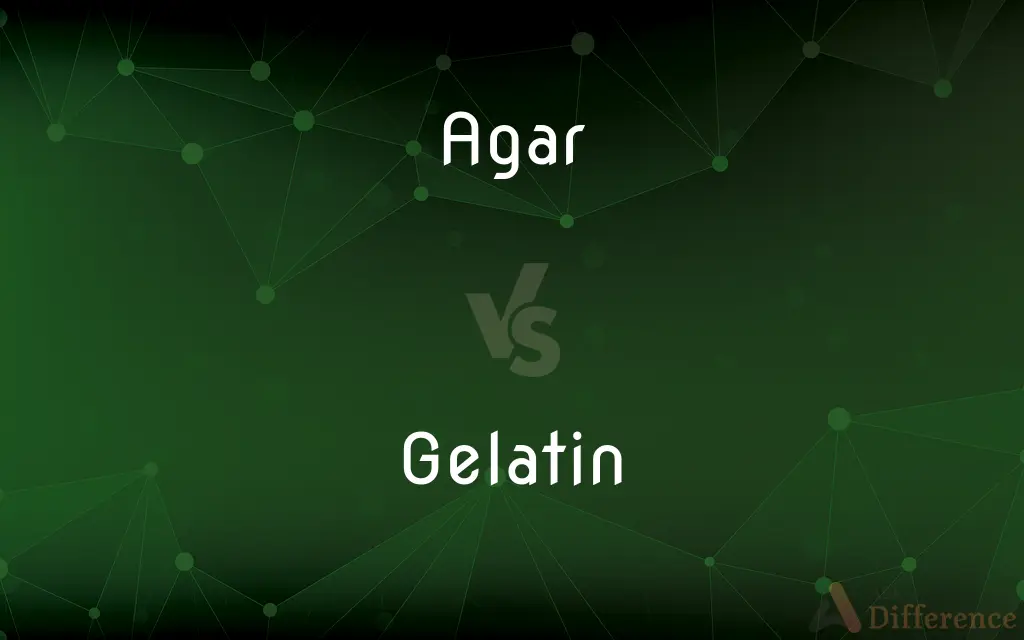Agar vs. Gelatin — What's the Difference?
By Tayyaba Rehman — Updated on September 21, 2023
Agar is a plant-based gelling agent derived from seaweed, while Gelatin is an animal-based gelling agent made from collagen.

Difference Between Agar and Gelatin
Table of Contents
ADVERTISEMENT
Key Differences
In culinary and scientific realms, Agar and Gelatin are recognized as essential substances.
Agar, originating from red algae, is primarily a plant-based gelling agent, often utilized in vegan and vegetarian recipes. This substance, native to East Asia, has found utility in culinary arts and microbiological research. Gelatin, on the other hand, stems from animal origins, primarily sourced from collagen found in animal bones and connective tissues. Being versatile, Gelatin is often an integral part of desserts, confectionery, and certain pharmaceuticals.
While both Agar and Gelatin are famed for their gelling capabilities, they have differences in texture. Agar tends to produce a firmer texture, while Gelatin yields a softer, more gel-like consistency.
Furthermore, religious and dietary preferences might dictate the choice between Agar and Gelatin, given the plant versus animal origin of each. In essence, both these agents are valuable, but their application varies depending on the context and desired outcome.
Comparison Chart
Source
Derived from red algae/seaweed.
Derived from animal collagen, usually bones and tissues.
ADVERTISEMENT
Texture
Produces a firmer gel.
Produces a softer, more wobbly gel.
Heat Stability
Remains stable at higher temperatures.
Melts at body temperature.
Dietary Usage
Preferred in vegan/vegetarian diets.
Not suitable for vegans or some religious dietary laws.
Application
Commonly used in microbiology labs & Asian desserts.
Widely used in desserts, confectionery, and pharmaceuticals.
Compare with Definitions
Agar
A plant-derived gelling agent.
Vegan desserts often incorporate Agar as a substitute for gelatin.
Gelatin
An agent that induces gel-like consistency.
She used Gelatin to set the fruit jelly.
Agar
A vegetarian-friendly thickening agent.
The jelly had a firm consistency thanks to the Agar.
Gelatin
Commonly found in desserts and candies.
The panna cotta owes its silky texture to Gelatin.
Agar
A substance extracted from red algae.
Researchers utilize Agar plates to culture bacteria.
Gelatin
A protein derived from animal collagen.
The marshmallows contain Gelatin, making them unsuitable for vegetarians.
Agar
A seaweed-derived gelatin alternative.
Due to dietary restrictions, she opted for Agar-based pudding.
Gelatin
Gelatin or gelatine (from Latin: gelatus meaning "stiff" or "frozen") is a translucent, colorless, flavorless food ingredient, commonly derived from collagen taken from animal body parts. It is brittle when dry and gummy when moist.
Agar
Agar ( or ), or agar-agar, is a jelly-like substance obtained from red algae.Agar is a mixture of two components: the linear polysaccharide agarose and a heterogeneous mixture of smaller molecules called agaropectin. It forms the supporting structure in the cell walls of certain species of algae and is released on boiling.
Gelatin
A colorless or slightly yellow, transparent, brittle protein formed by boiling the specially prepared skin, bones, and connective tissue of animals and used in foods, drugs, and photographic film.
Agar
A gelatinous substance obtained from certain red seaweeds and used in biological culture media and as a thickener in foods.
Gelatin
Any of various similar substances.
Agar
A gelatinous material derived from certain marine algae. It is used as a base for bacterial culture media and as a stabilizer and thickener in many food products.
Gelatin
A jelly made with gelatin, used as a dessert or salad base.
Agar
A culture medium containing this material.
Gelatin
A thin sheet made of colored gelatin used in theatrical lighting. Also called gel.
Agar
A gelatinous material obtained from red algae, especially Gracilaria species, used as a bacterial culture medium, in electrophoresis and as a food additive.
Gelatin
A protein derived through partial hydrolysis of the collagen extracted from animal skin, bones, cartilage, ligaments, etc.
Agar
A culture medium based on this material.
Gelatin
An edible jelly made from this material.
Agar
Agarwood
Gelatin
A thin, translucent membrane used as a filter for photography or for theatrical lighting effects.
Agar
Common shortened form of agar-agar{2}.
Gelatin
Animal jelly; glutinous material obtained from animal tissues by prolonged boiling. Specifically (Physiol. Chem.), a nitrogeneous colloid, not existing as such in the animal body, but formed by the hydrating action of boiling water on the collagen of various kinds of connective tissue (as tendons, bones, ligaments, etc.). Its distinguishing character is that of dissolving in hot water, and forming a jelly on cooling. It is an important ingredient of calf's-foot jelly, isinglass, glue, etc. It is used as food, but its nutritious qualities are of a low order.
Agar
Any culture medium that uses agar as the gelling agent; - used especially with a modifying prefix, as, EMB agar. The term is applied both to the dehydrated medium powder containing agar and to the gelatinous medium prepared from it.
Gelatin
A colorless water-soluble glutinous protein obtained from animal tissues such as bone and skin
Agar
Any culture medium that uses agar as the gelling agent
Gelatin
An edible jelly (sweet or pungent) made with gelatin and used as a dessert or salad base or a coating for foods
Agar
A colloidal extract of algae; used especially in culture media and as a gelling agent in foods
Gelatin
A thin translucent membrane used over stage lights for color effects
Agar
A staple in microbiological studies.
The Agar medium facilitated the growth of the microorganisms.
Gelatin
Sourced primarily from animal bones and tissues.
Certain capsules use Gelatin as their primary ingredient.
Gelatin
A substance that dissolves in warm water.
Gelatin sheets need to be soaked before being melted into mixtures.
Common Curiosities
Why is Agar commonly used in labs?
Agar is used in labs as a culture medium for microbiological research.
Is Gelatin vegetarian?
No, Gelatin is of animal origin and not suitable for vegetarians.
Are there any dietary restrictions associated with Gelatin?
Yes, being animal-derived, Gelatin may not be suitable for vegans, vegetarians, or certain religious diets.
Can Agar be used as a direct substitute for Gelatin?
Yes, Agar can substitute Gelatin, but the resulting texture may vary.
Which gelling agent is more heat-stable?
Agar has a higher heat stability compared to Gelatin.
How does the texture of Agar compare to that of Gelatin?
Agar produces a firmer texture, while Gelatin gives a softer, wobbly consistency.
In what form is Agar commonly sold?
Agar is typically sold as flakes, powder, or bars.
What is Agar primarily derived from?
Agar is derived from red algae or seaweed.
What is the main source of Gelatin?
Gelatin is sourced from animal collagen, typically from bones and tissues.
Is Agar a recent discovery?
No, Agar has been used for centuries, especially in Asian cuisines.
Can I use Gelatin in vegan dishes?
No, Gelatin is animal-derived, making it unsuitable for vegan dishes.
Are there any common desserts where Gelatin is a key ingredient?
Yes, desserts like jellies, panna cotta, and some mousses often contain Gelatin.
What are the health benefits of Agar and Gelatin?
Both can aid digestion, and Gelatin is known for supporting joint and skin health, while Agar offers dietary fiber.
What happens when Gelatin is exposed to warm temperatures?
Gelatin can melt when exposed to temperatures close to or at body temperature.
Why might someone choose Agar over Gelatin in cooking?
Dietary preferences, vegetarian or vegan diets, or desired texture can dictate the choice of Agar over Gelatin.
Share Your Discovery

Previous Comparison
Electrophile vs. Nucleophile
Next Comparison
Softbound vs. HardboundAuthor Spotlight
Written by
Tayyaba RehmanTayyaba Rehman is a distinguished writer, currently serving as a primary contributor to askdifference.com. As a researcher in semantics and etymology, Tayyaba's passion for the complexity of languages and their distinctions has found a perfect home on the platform. Tayyaba delves into the intricacies of language, distinguishing between commonly confused words and phrases, thereby providing clarity for readers worldwide.
















































